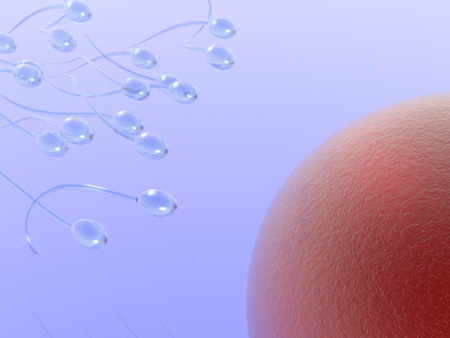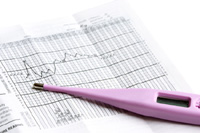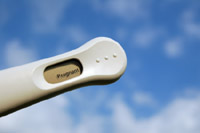Trying to Fall PregnantHow long does it normally take?
It is important to note that it often takes up to a year, even for a young healthy fertile couple, to become pregnant. It is estimated that 3 out of five couples conceive within 6 months of trying and 1 in 4 take between 6 months to a year. For the rest conception takes more than a year. Couples who have not used any form of contraception and who have not become pregnant after a year of regular (at least twice a week) sexual intercourse may wish to see a doctor and have some tests done. Women are most fertile between 20 and 24 years of age. After this, fertility gradually decreases with age. If the female partner is older than 35, and therefore closer to the end of her reproductive life, or if there are any known reproductive issues, it is suggested that couples seek medical assistance earlier. Additionally, some couples may wish to contact their local doctor sooner, since they have questions about the timing of intercourse, other reproductive facts and they may be worried that things are not working. In these cases talking about your concerns with your local doctor is a great idea. Timing of Intercourse is ImportantOften people experience difficulties in becoming pregnant when they do not time sexual intercourse with ovulation. Ovulation is when one or more eggs are released from a woman's ovaries into her reproductive tract and this is the fertile time of a woman's menstrual cycle. Each month 12 to 20 eggs mature inside the ovaries and the ripest egg is released into the pelvic cavity and moved into the fallopian tube. It is here in the fallopian tube, that the egg and a sperm need to meet before the egg dies, for a natural pregnancy to occur. This can be difficult to time, especially since the egg is fertile only for about 12 to 24 hours after it has been released. However, sperm can live for up to 3-7 days in the fertile cervical mucus present in a woman's cervix and vagina in the few days leading up to ovulation. Therefore, to get pregnant you do not have to have sex at the exact moment of ovulation and there seems to be this 4 day window of opportunity, which is your ‘fertile window', and it is suggested that sexual intercourse should start to happen around 2-3 days before ovulation. Predicting OvulationOvulation is usually around 12 to 14 days before the start of a woman's next period. The first day of your period is day one of your menstrual cycle. The day before your next period begins, is the last day of your menstrual cycle. If your cycle is 28 days long, then your ovulation day is likely to be day 14. However, women's menstrual cycles can range from about 21 to 40 days and some women do not ovulate consistently. Therefore, some women may like to use home ovulation kits, temperature charts, or cervical mucus checking to determine when they ovulate. Ovulation Predictor Kits can help you identify and predict your ovulation in advance. However, please keep in mind that there is no evidence to suggest that using these ovulation predictor kits will increase your chances of getting pregnant naturally and it is regular sex throughout your cycle what is recommended to increase your chances. These kits are available at most pharmacists, chemist and supermarkets without prescription, located in the section of pregnancy products or condoms. There are 2 types of Ovulation Predictor Kits:
Checking your Cervical Mucus can give you an indication of your fertile window, since the type of cervical mucus your body produces can provide clues about your fertility. Generally, the mucus from your cervix is light or sticky, which is when you are least fertile. But during the few days leading up to ovulation, you will notice a change in your cervical mucus, which is due to the increase of oestrogen levels. You will have more discharge and the texture tends to become clear and slippery. You are most fertile and most likely to conceive on the last day you notice this kind of cervical mucus. Please contact your local doctor if you are not sure. Frequency of Intercourse and Ejaculation is Important
Furthermore, Australian research by Dr. Greening, a specialist in reproductive endocrinology and fertility, has found that ejaculating daily substantially improves the genetic quality of sperm, without lowering sperm counts enough to impair fertility. The optimal number of days of ejaculation might be more or less than 7 days, but a week appears manageable and favourable. This research suggests couples should have sex daily for up to a week before the female partner ovulates to improve sperm quality and ultimately achieving a pregnancy. They also found that although frequent ejaculation decreased semen volume and sperm concentrations, it did not compromise sperm motility and, in fact, this rose slightly but significantly. In addition, these results may mean that men play a greater role in infertility than previously suspected, and that ejaculatory frequency is important for improving sperm quality, especially as men age and during assisted reproduction cycles. Reference: 2009, European Society for Human Reproduction and Embryology. [Online]. Available: http://www.eshre.com/ESHRE/English/Annual-meeting/Amsterdam/Press/Press-releases/Days-and-quality/page.aspx/757
Sex therapy and Relationship Counselling is available in Sydney, New South Wales (NSW) - Melbourne, Victoria (VIC) - Adalaide, South Australia (SA) - Perth, Western Australia (WA) - Darwin, Northern Territories (NT) - Hobart, Tasmania (TAS) - Brisbane, Queensland (QLD) - Canberra, Australian Capital territory (ACT) |
|
|


 Charting your Temperature can be helpful so you can see whether there is a pattern to your cycle. The temperature you should measure is your basal body temperature. This is your temperature when you first wake up in the morning before you even get out of bed to start your day. You would measure it by placing a basal thermometer into your mouth, which is available at chemists. This basal thermometer differs from a regular thermometer as it displays minute incremental degree changes. Hormonal changes that happen during your ovulation will trigger a slight rise in your basal body temperature. This rise will last until your next period. You are most likely to conceive between the day of your temperature rise and a few days after it.
Charting your Temperature can be helpful so you can see whether there is a pattern to your cycle. The temperature you should measure is your basal body temperature. This is your temperature when you first wake up in the morning before you even get out of bed to start your day. You would measure it by placing a basal thermometer into your mouth, which is available at chemists. This basal thermometer differs from a regular thermometer as it displays minute incremental degree changes. Hormonal changes that happen during your ovulation will trigger a slight rise in your basal body temperature. This rise will last until your next period. You are most likely to conceive between the day of your temperature rise and a few days after it. Additionally infrequent sexual activity is also a common reason why couples do not become pregnant within the first few months. To increase your likelihood of conception, you would need to have sex in the few days leading up to ovulation. Since it is not always easy to predict ovulation, it is suggested that you have sex 2 to 3 times a week throughout your cycle. This will in turn increase your chances that a healthy supply of sperm is present in the fallopian tube to fertilise the egg once it is released.
Additionally infrequent sexual activity is also a common reason why couples do not become pregnant within the first few months. To increase your likelihood of conception, you would need to have sex in the few days leading up to ovulation. Since it is not always easy to predict ovulation, it is suggested that you have sex 2 to 3 times a week throughout your cycle. This will in turn increase your chances that a healthy supply of sperm is present in the fallopian tube to fertilise the egg once it is released. 
